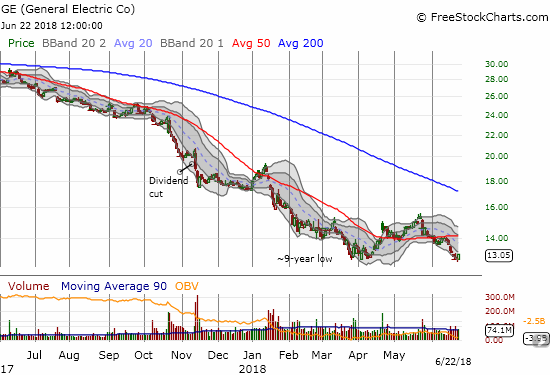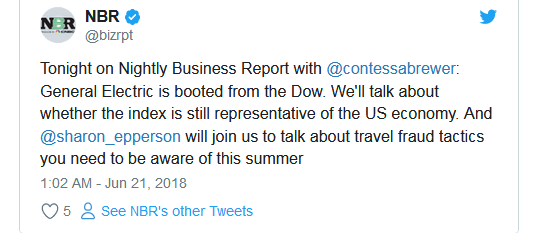The big index news of last week was General Electric (NYSE:GE) getting dumped by the Dow Jones Industrial Average (DJIA) index. The index managers at the Dow picked Walgreens Boots Alliance (NASDAQ:WBA) to replace GE.

A long and painful descent for General Electric (GE) into the abyss and out of the Dow.
I wish the entire Dow index could follow after GE. Traders do not use the Dow for anything except to check the temperature of the sentimental headlines attached to the Dow’s movements. As a price-weighted index of just 30 stocks, the Dow is not useful for much else. An interview on Nightly Business Report titled “Is the Dow Still Representative of American Economy” with David Blitzer, the Managing Director and Chairman of the Index Committee at the S&P Dow Jones Indices, was a glaring reminder of the Dow’s anachronistic and inferior standing among the major indices.
First of all, Blitzer claimed that replacing GE was not about GE itself. The move was about making the index “even better” and “more representative” of the American stock market and the economy. I claim that by definition these reasons suggest that continuing to keep GE in the index prevented the index from being as good as it supposedly can be. Next, Blitzer pointed out that GE’s low price meant that it had very little impact on the Dow (remember, the Dow is price-weighted, so the bigger the price, the bigger the impact). Again, I claim by definition, this drawback means that GE’s removal IS about GE.
This weak attempt to deflect from GE-specific deficiencies was a good segue to the real issue of price-weighting as a poor construct for an index. Blitzer admitted that price-weighting is an “odd way” to create an index, but he defended the practice as the “long-time standard way.” Fortunately, the host Contessa Brewer went straight for the contentious issue of price-weighting. She asked point blank whether price-weighting is still representative of the American economy and whether this method is still the right way to run a modern index. Blitzer squirmed just a touch, stiffened his composure, and admitted that “we” have been having a lot of these conversations in the last week. Here is how Blitzer defended the Dow’s price-weighting methodology:
“To change the Dow we would be tossing away about 125 years of financial history. A longer series of history than almost anyone else has that’s consistently reliable. We’d also have to rejigger it substantially, and it would come out looking very different, and it would probably come out looking more like the S&P 500. So I think we’re happy with the way it is. It’s not the only way to run an index, but it’s a tried and true way to run an index.”
Blitzer might as well have said he and his colleagues are keeping the Dow because it already exists. I submit that having history does not equate with value. Note that Blitzer did not provide a single point that referenced the utility or usefulness of the Dow. The Dow is like the first car your parents gave you to drive as a kid: sure you could keep it throughout your adult life, but you will have to go to greater and greater lengths to explain to people why that heap of junk is still sitting in your driveway.
The deficiency of the Dow was further exposed when Blitzer tried to answer why neither Netflix (NASDAQ:NFLX) or Amazon.com (NASDAQ:AMZN) were added to the Dow. Blitzer chose to focus on AMZN, pointing out that the Dow has enough technology representation. He also called AMZN a retail company presumably implying that Walmart (NYSE:WMT) and Nike (NYSE:NKE) already provide sufficient representation from the retail perspective.
Blitzer was most enlightening when he rightfully pointed out that AMZN’s large price (currently $1715.67) would have such a large impact on the Dow that it would become the Amazon Index. So, if AMZN simply SPLIT its stock 10:1, then suddenly this $832B company would look a lot more attractive as an index member. Yet, a stock split would not change the fundamentals of the company or its relevance to the American economy and financial markets. AMZN’s massive market cap, over three times larger than WMT, would also stay the same. Ironically, NKE is barely bigger than GE…a fact that brings me to the glaring oddity of booting GE from the Dow essentially because its price got too small.
Despite its low price, GE’s market cap of $113B is still larger than four other members of the Dow: The Travelers Companies, Inc. (NYSE:TRV) at a paltry $34B, Caterpillar Inc. (NYSE:CAT) at $84B, The Goldman Sachs Group, Inc. (NYSE:GS) at $85B, and United Technologies Corporation (NYSE:UTX) at $100B. GE is not much smaller than index members 3M Company (NYSE:MMM) at $117B, NIKE, Inc. (NKE) at $118B, or McDonald’s Corporation (NYSE:MCD) at $129B. So if the Dow Index committee gave GE a chance to do a 1:10 reverse stock split, the case for removing GE would have become much weaker.
Enough already. I will continue ignoring the Dow in my own market observations, and I wish more people would do the same.

Full disclosure: long GE call options
